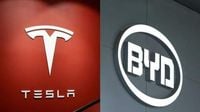Tesla has long been the dominant force in the electric vehicle (EV) market, but a new competitor is rapidly gaining ground. BYD, a Chinese automaker, is not only challenging Tesla's supremacy but also outpacing it in certain aspects, particularly in revenue and technological advancements. As the electric vehicle landscape evolves, the rivalry between these two companies is intensifying, raising questions about the future of the EV market.
In 2024, BYD reported a staggering annual revenue of $170 billion, surpassing Tesla’s $155.5 billion. This shift marks a significant milestone in the competitive dynamics of the EV sector, as BYD's innovative technologies and strategic pricing are beginning to resonate with consumers worldwide.
One of BYD's most exciting developments is its upcoming model, which boasts the ability to drive up to 400 kilometers after just five minutes of charging. This remarkable charging capability is made possible by an "all liquid-cooled megawatt flash charging terminal system" that includes a cutting-edge 1500-volt silicon carbide power chip and a flash-charging battery with ultra-fast ion channels. These innovations allow for a recharging rate of about two kilometers per second, making it the fastest charging system available in the passenger EV market.
In contrast, Tesla's superchargers can provide a 275-kilometer range in 15 minutes, a notable achievement but significantly slower compared to BYD's offering. The competition doesn’t stop there; Li Auto, another Chinese manufacturer, can achieve a 500-kilometer range in just 12 minutes. As BYD prepares to launch its Han L and Tang L sport utility vehicles in April 2025, the pricing strategy also suggests a keen awareness of market dynamics. The starting prices for these models are C$53,224 (270,000 yuan) and $55,196 (280,000 yuan), while the extended range option for BYD's Han EV costs $45,300 (229,800 yuan). In comparison, the Tesla Model Y starts at $64,990 in Canada.
While BYD's vehicles are gaining traction due to their advanced technology and lower price points, Tesla is not without its challenges. The company has experienced a decline in sales momentum, attributed in part to controversies surrounding CEO Elon Musk. As Musk has taken on a more prominent role in public discourse and government relations, many Tesla users have expressed dissatisfaction, prompting them to explore alternatives.
Amid these challenges, BYD has emerged as a viable option for consumers seeking electric vehicles that combine affordability with cutting-edge technology. The Chinese automaker's commitment to research and development has positioned it as a formidable competitor in the EV market, particularly in regions where tariffs on Chinese imports are a barrier.
In the United States, electric vehicles produced in China face 100% tariffs, which complicates BYD's entry into the market. However, the company is strategically expanding its production facilities in Europe, with plans to build a third manufacturing plant in Germany, thereby reaching European customers without the burden of import tariffs. This expansion is a clear indication of BYD's ambition to solidify its presence in the global EV market.
Despite the challenges posed by tariffs, the advancements in BYD's technology are hard to ignore. For instance, BYD's Blade battery technology, distinct from Tesla's cylindrical cells, allows for more efficient heat management without the need for external cooling systems. This not only reduces production costs but also enhances the overall performance of the vehicles. Tesla, on the other hand, faces the challenge of managing heat generation, as its vehicles produce twice as much heat per volume and require additional cooling mechanisms.
Experts note that while BYD's rapid charging capabilities are impressive, there are infrastructure challenges to consider. The advanced liquid-cooled charging systems may require significant upgrades to existing power grids, which could entail high costs and logistical hurdles. Additionally, while fast charging can alleviate some consumer anxiety regarding wait times, it raises concerns about the long-term durability of batteries subjected to such rapid recharging.
As both companies navigate this competitive landscape, the question remains: will Tesla be able to reclaim its position as the leader in the EV market? The emergence of BYD is forcing established players like Tesla to innovate and rethink their strategies. As the rivalry intensifies, both companies will need to focus on their core pillars of design and sustainability while adapting to the evolving demands of consumers.
In conclusion, the battle between Tesla and BYD is more than just a competition for sales; it represents a broader shift in the electric vehicle market. As consumers become more discerning and technology advances at a rapid pace, the dynamics of this industry will continue to evolve. With BYD's impressive growth and innovative technologies, Tesla may need to reassess its strategies to maintain its competitive edge in an increasingly crowded marketplace.





